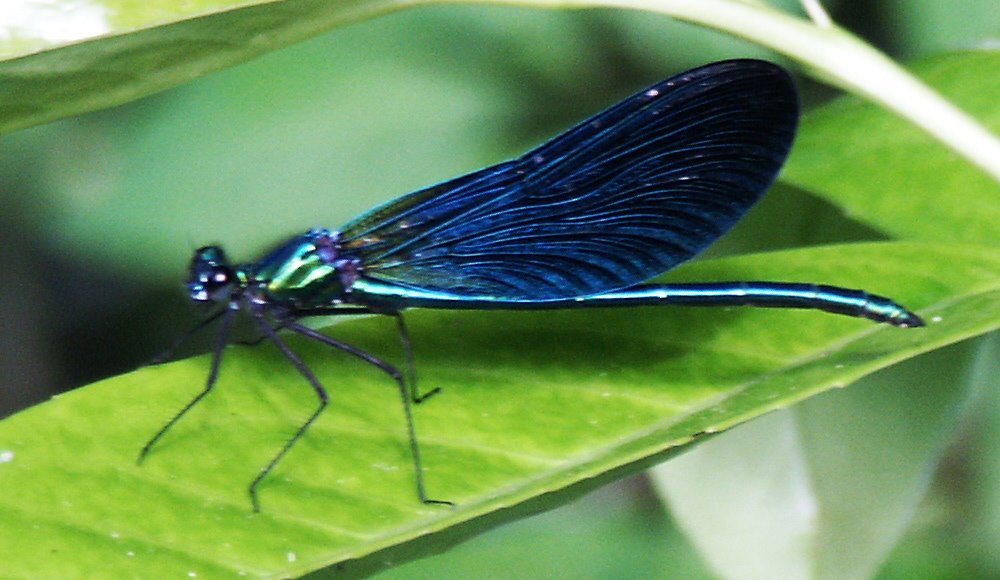Scientific Name: Calopteryx virgo.
English Name: Beautiful Demoiselle.
French Name: Le Caloptéryx vierge.

5 Key Characters:
Habitat: Small fairly fast running woodland streams, especially if in steep sided valleys with some sunny spots. The small streams feeding acidic lakes in the Sologne. They avoid large water courses and are highly intolerant of organic pollution. Adults perch on bankside trees and vegetation. Males are territorial and flick their wings to attract females or repulse other males.
Flight Period: April-May-June-July-August-September-October.
Status: Fairly common although they are considerably threatened by modern agricultural practices and 'improvements' to water courses. The complete suppression of bankside trees and bushes and the slashing of vegetation should be avoided if the species is to remain.
Photographed by Loire Valley Nature:
Photographs are numbered from left to right and top to bottom. All photos will enlarge into a new window if you click on them. 1 two male Calopteryx sp. Top right is C. virgo, bottom left is C. splendens - a relatively uncommon example of the two species sharing a habitat, in this case sitting on a Black Alder Alnus glutinosa on the banks of a bief (millstream) in the Aigronne Valley, May. 2 female, Aigronne Valley, May. Note the short bayonnet shaped lateral suture (the yellow mark on the side of the thorax) and the wide golden brown wings. Using Photoshop, the distance between the node and the pseudopterastigma has been calculated as 4 times the distance from the tip to the pseudopterastigma - just on the limit of the ratio acceptable for C. virgo.
English Name: Beautiful Demoiselle.
French Name: Le Caloptéryx vierge.

5 Key Characters:
- the wings of males wide, paddle shaped and more or less entirely dark purplish or greenish blue.
- underneath the last 3 segments on the male's abdomen (known as their 'tail light') orangey or browny red.
- large and robust for a damselfly (45 - 49 mm long).
- male bodies dark metallic blue, female bodies bronzy green.
- female wings broad and distinctly tinted golden brown.
Habitat: Small fairly fast running woodland streams, especially if in steep sided valleys with some sunny spots. The small streams feeding acidic lakes in the Sologne. They avoid large water courses and are highly intolerant of organic pollution. Adults perch on bankside trees and vegetation. Males are territorial and flick their wings to attract females or repulse other males.
Flight Period: April-May-June-July-August-September-October.
Status: Fairly common although they are considerably threatened by modern agricultural practices and 'improvements' to water courses. The complete suppression of bankside trees and bushes and the slashing of vegetation should be avoided if the species is to remain.
Photographed by Loire Valley Nature:
Photographs are numbered from left to right and top to bottom. All photos will enlarge into a new window if you click on them. 1 two male Calopteryx sp. Top right is C. virgo, bottom left is C. splendens - a relatively uncommon example of the two species sharing a habitat, in this case sitting on a Black Alder Alnus glutinosa on the banks of a bief (millstream) in the Aigronne Valley, May. 2 female, Aigronne Valley, May. Note the short bayonnet shaped lateral suture (the yellow mark on the side of the thorax) and the wide golden brown wings. Using Photoshop, the distance between the node and the pseudopterastigma has been calculated as 4 times the distance from the tip to the pseudopterastigma - just on the limit of the ratio acceptable for C. virgo.


 |
| A male lands on my boot along the millstream (Fr. bief) in Le Petit Pressigny. |
 |
| Courtship, female on twig, male flying, above a small stream near Panzoult. |






I really wish this family extended to Australia - they're so stunning! The family extends to New Guinea but it seems the single record of the Papuan Demoiselle from Cape York from the 19th century is disputed ("has not been confirmed".
ReplyDeleteHarvey: They are just gorgeous and extremely watchable. I'm sure they are the origin of some 19th C 'fairies at the bottom of the garden' stories -- they are so twinkly and have a very distinctive manner of flying, quite languid for a damselfly.
ReplyDelete